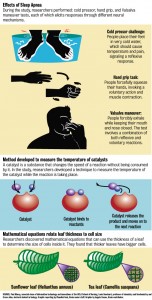
The original graphic accompanying this article contained an error and has been changed. See the bottom of the article for additional information.
Take a look at recently published studies by UCLA researchers covering topics including sleep apnea, catalysts and leaf anatomy.
Effects of sleep apnea
UCLA researchers discovered that people with sleep apnea, a disorder in which people cannot breathe properly while sleeping, have slower and weaker heart rate responses than those who do not have the disease. The study was funded by the National Institutes of Health.
“What we’re seeing here is how the cardiovascular system is regulated and is out of wack,” said Paul Macey, a professor at the UCLA School of Nursing and lead investigator of the study. ”It isn’t just the breathing – it’s the whole cardiovascular system.”
The researchers tested people’s heart rates in response to squeezing their hands, blowing air out and putting their feet in cold water.
People who have obstructive sleep apnea did not have the same degree of change in heart rate as those who do not have the disease, Macey said.
Women are more likely than men to be affected by problems related to obstructive sleep apnea, according to the study.
However, as the study included six women and 31 men with obstructive sleep apnea, Macey said that further studies need to be done in order to prove this conclusively.
The researchers are following up with a five-year project to look at gender differences in obstructive sleep apnea.
—
Method developed to measure temperature of catalysts
UCLA researchers have developed a technique to determine the temperature inside small catalytic reactors, according to a study published recently.
The technique uses MRI and radio frequencies to detect the temperature inside the catalysts. Other devices, such as thermometers, cannot be used because they will not provide accurate readings, said Louis Bouchard, a professor of chemistry and biochemistry and senior author of the study. The device will block the flow of gases, thus changing the temperature inside the catalyst, Bouchard said.
The method can have applications in the chemical industry and help increase the efficiency of chemical reaction, he said.
“You can make more efficient reactions with less waste (through this technique),” Bouchard said. “If you operate at lower temperature, you use less energy. If the catalysts last longer because you don’t beat them up as much, you don’t need to (synthesize) new catalysts.”
—
Mathematical equations relate leaf thickness to cell size
Mathematical equations relating the size of a leaf and the size of the cells were discovered by UCLA researchers. The study was funded by the National Science Foundation.
The aim of the study was to determine how leaves are designed from the inside, said Lawren Sack, a professor in ecology and evolutionary biology who worked on the study.
“If you build anything of a particular design large enough, it begins to fail. Without modifying a building design, if you made a pretty large version, it would just collapse. Leaves are really highly efficient – they can (vary) many thousand fold across species,” Sack said.
The researchers sampled 14 different species and looked at magnified images of thin cross sections, said Grace John, a doctoral student in biology and the lead researcher of the study.
The study showed that leaf thickness is directly related to the size of cells inside the leaf and the thickness of their cell walls, John said.
“As you make a bigger cell, you’d want to have a bigger cell wall to support the cell. It’s like if you have a bigger bridge, you would need bigger columns,” John said.
John conducted the study as part of her thesis looking at water efficiency and drought tolerance in trees in Los Angeles, she said.
Compiled by Chandini Soni, Bruin senior staff.
Correction: The word “reflexive” was misspelled.